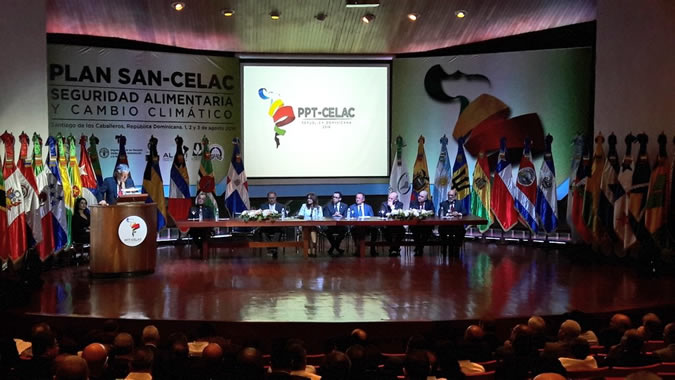Climate Change Threatens the Basis of Food Security in Latin America and the Caribbean: Agriculture
According to a report by FAO, ECLAC and ALADI, climate change will affect crop yields, local economies and food security in Northeastern Brazil, Central America and parts of the Andean region.

The impact of climate change in Latin America and the Caribbean will be considerable because of its economic dependence on agriculture, the low adaptive capacity of its population and the geographical location of some of its countries, notes a new study by FAO, ECLAC and ALADI.
The study was presented today at the meeting of the Community of Latin American and Caribbean States (CELAC), in Santiago de los Caballeros, Dominican Republic, as a key input to incorporate climate change management in the Plan for Food Security, Nutrition and Hunger eradication of CELAC 2025.
According to the three agencies, the agricultural sector is the most affected by climate change, which is essential when considering that it contributes 5% of regional GDP, 23% of regional exports and employs 16% of the economically active population.
"With a structural change in the patterns of production and consumption and a big environmental push, Latin America and the Caribbean can achieve the second objective of the Sustainable Development Goals, ending hunger, achieving food security and improving nutrition while promoting sustainable agriculture, "said Antonio Prado, Deputy Executive Secretary of the United Nations Economic Commission for Latin America and the Caribbean (ECLAC), while introducing the report in the Dominican Republic.
According to Prado, the Food Security Plan of CELAC and the new Forum of the Countries of Latin America and the Caribbean on Sustainable Development will be two fundamental pillars for this process.
The report by the three agencies highlights that climate change will affect crop yields, impact local economies and jeopardize food security in Northeast Brazil, part of the Andean region and Central America.
"The challenge for the region is considerable: how to continue the positive process of eradicating hunger as the effects of climate change on production systems become deeper and more notorious," said Raul Benitez, FAO's Regional Representative to the ministers of CELAC.
The countries whose agricultural sectors will suffer the greatest impacts (Bolivia, Ecuador, El Salvador, Honduras, Nicaragua and Paraguay) also face significant challenges in terms of food security.
Some countries in the region, as well as CELAC, have already taken important steps in designing plans for adaptation of the agricultural sector to climate change, but the challenges are still considerable. Only in terms of financial resources, without taking into account the necessary policy changes, it will require around 0.02% of annual regional GDP.
Impacts on agriculture and food security
Paradoxically, although the region produces a lower contribution to climate change in terms of their emissions of greenhouse gases compared to others, it is especially vulnerable to its negative effects.
The new report projects movements -in altitude and latitude- in the optimal areas for the cultivation of important crops such as coffee, sugar cane, potatoes and corn, among others.
At the national level, these impacts can seriously affect food security: according to the report, in Bolivia, changes in temperature and precipitation would cause an average reduction of 20% in rural incomes.
In the case of Peru, projections indicate that the impact of climate change on agriculture would generate decreases in the production of various staple crops for food security, especially those that require more water, like rice.
But the agricultural sector not only receives the impacts of climate change, but also contributes to its effects, so it is urgent that countries -with the support of CELAC- make an urgent transition to sustainable agricultural practices, both in environmental, economic and social terms.
According to the three agencies, the eradication of hunger in Latin America and the Caribbean requires a paradigm shift, a fully sustainable agricultural model that protects its natural resources, generates equitable socio-economic development and allows adaptation and mitigation of climate change effects.
Changes in rainfall threaten food security in Mesoamerica
The report stresses that climate change will increase both drought and excessive rains.
On the one hand, it will generate a decrease in the availability of water for food production and other uses in semiarid areas and in the tropical Andes, the result of glacial retreat, reduced precipitation and increased evapotranspiration in semiarid areas.
This is already affecting the countries of the Central American dry corridor, where some 3.5 million people need humanitarian assistance and 1.6 million live in moderate or severe food insecurity in the most affected countries: El Salvador, Guatemala and Honduras.
On the other hand, it is estimated that heavy rainfall will increase by approximately 7% for each degree Celsius of temperature increase, with negative consequences for agriculture, as worsening erosion, increased runoff with loss of available water and even damage to crops themselves.
Changes in the distribution of rainfall throughout the year can threaten the "milpa" production system (agro-ecosystem which grows corn, beans and squash simultaneously), which underlies food security in rural areas of Mesoamerica.
All these aspects should be considered by countries and by CELAC in their food security strategies, for the region to meet its goal of eradicating hunger by 2025 and to make progress towards the Sustainable Development Goals.
More information:
For queries, contact:
ECLAC’s Public Information Unit
E-mail: prensa@cepal.org; Telephone: (56) 22210 2040.
Follow us on Twitter, Facebook, Flickr, YouTube and Google+.
FAO Regional Office for LAC
Benjamín Labatut - benjamin.labatut@fao.org
Telephone: (56) 229 232 174.
Related content

CEPAL reafirma su apoyo a la CELAC para la erradicación del hambre en la región
Antonio Prado, Secretario Ejecutivo Adjunto del organismo regional, participó en reunión de trabajo en Santiago de los Caballeros, República Dominicana.
Subregional headquarter(s) and office(s)
Country(ies)
- Latin America and the Caribbean
Related project(s)
Contact
Public Information Unit
- prensa@cepal.org
- (56 2) 2210 2040